
Belmont - urban town center emerging on Occoquan River, east of I-95
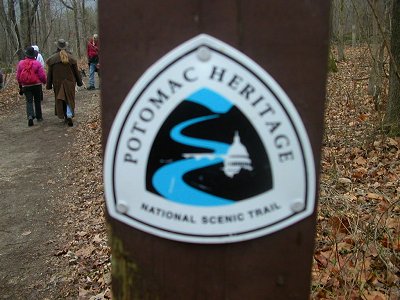
If current trends continue over the next 50 years, Loudoun, Prince William, and Stafford counties will transform just as Arlington and Fairfax County has suburbanized and then urbanized in the last 50 years. The Boston-Washington corridor will extend to become the Boston-Virginia Beach corridor, as development crowds I-95 south to Petersburg and then east along I-64 to Virginia Beach.
Development pressure may be so intense that no places may be left undeveloped for routing the Potomac Heritage National Scenic Trail in eastern Prince William County. The official route may be interrupted, rather than follow a paved highway until reaching preserved areas in Fairfax and Stafford counties.
Over the next 50 years, existing unprotected open space in Northern Virginia, the parcels now undeveloped, will disappear. The cities - Alexandria, Falls Church, Fairfax, Manassas, Manassas Park, and Fredericksburg - developed first and are already "built out."
Throughout Fairfax, Loudoun, Prince William, Fauquier, and Stafford counties you can see properties that were once farmland, but were abandoned in the last 50 years. We've already seen build-out in Arlington County, and Fairfax County will complete the process soon. The last of those old farms, some of which are covered by 50-year old forests now, will become houses.
"Between 1980 and 1990, vacant land in Fairfax County diminished by more than 30,000 acres. Between 1990 and 2000, vacant land diminished by an additional 15,500 acres. As of January 2004, Fairfax County had only 24,093 acres of zoned but vacant land."1 Statewide, "[o]f all the development that has occurred in the last 400 years, more than a quarter of it has taken place in the last 15 years."2
Why does open land in Northern Virginia disappear? Why doesn't it stay vacant forever? After all, if you drive in rural areas in the Rest of Virginia (ROVA), some of those parcels won't become townhomes or Wawa's. Why is every parcel in our region destined to get developed?
As Northern Virginia suburbanized, people who used to work on farms for low wages took jobs in the construction industry. The death knell for the dairy industry in Loudoun County was the construction of Dulles Airport. Farmers could shift to raising beef cattle, which did not require milking cows twice a day, but rising land values and rising property taxes made farming uneconomic.
Few children who were raised in Northern Virginia after World War Two chose to become farmers, so the family tradition of passing the farm to the next generation was broken. The highest and best use of the land was for suburban development, and farmers reacted like rational people. They retired, and sold their land to developers.

Don't blame the farmer for development. Don't blame the developer. Blame the people who moved to Northern Virginia, and created the demand for housing units, retail stores, office complexes, and a road network to connect where we live with where we work/shop. Blame yourself. Unless you live in downtown Alexandria or Dumfries, odds are very good that where you are living today was a farm 200 years ago.
As the region develops, the traditional transportation network will be unable to expand to meet increasing demand. Demand for wider roads may drop dramatically if the cost of gas reaches $10/gallon and people choose to carpool/take transit. In that case, proposals to widenm roads may be altered into context-sensitive solutions to maintain current road widths, but alter road design to reduce the impact on the communities bisected by the roads. Just because Northern Virginia is growing in population does not mean every road must be expanded to 6 lanes...
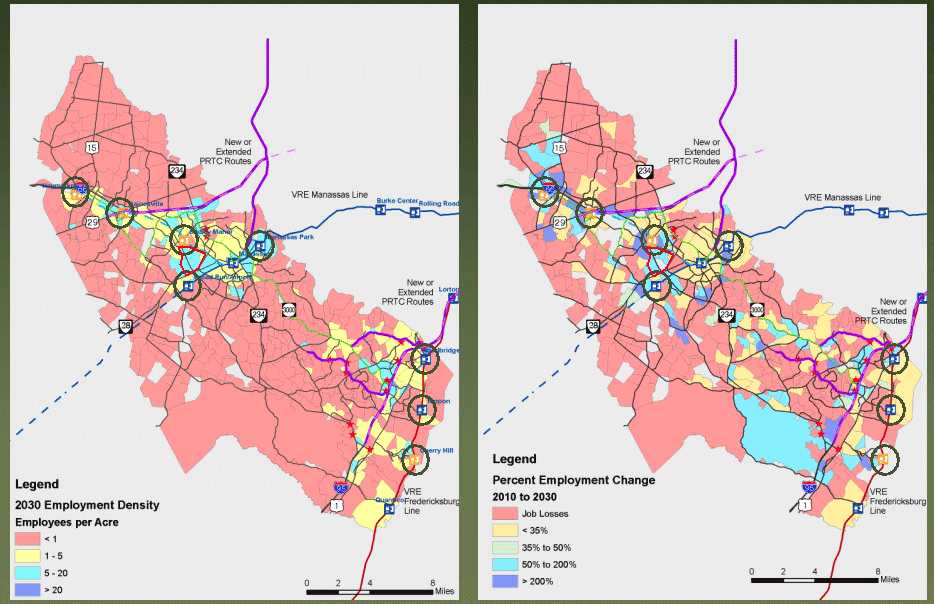
In 2050, the remaining open space will be whatever lands are officially off-limits to development. Much of this will be public land, acquired for schools, parks, even roadway corridors with trails parallel to the paved lanes. Some undeveloped areas may be acquired as local governments require developers to "proffer" parkland in exchange for approval of new subdivisions. Most remaining open space in 2058 is likely to be protected as the common area of home owner associations - so it could be closed to public use.
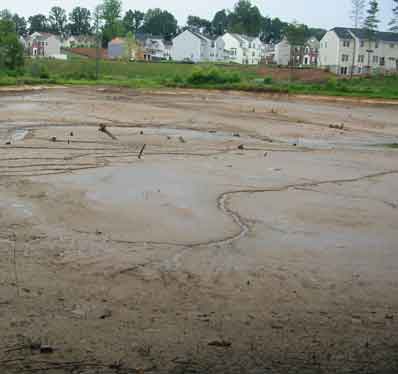 In Fairfax, over the last 20 years a forward-looking county government acquired title to stream valleys as public land. The county accepted responsibility for maintaining Resource Preservation Areas (RPA's) as it approved proffers, ensuring buffers would stay protected and enabling the county to establish a network of trails. In 2058, that "green infrastructure" will add greatly to the quality of life in Fairfax.
In Fairfax, over the last 20 years a forward-looking county government acquired title to stream valleys as public land. The county accepted responsibility for maintaining Resource Preservation Areas (RPA's) as it approved proffers, ensuring buffers would stay protected and enabling the county to establish a network of trails. In 2058, that "green infrastructure" will add greatly to the quality of life in Fairfax.
In contrast, Prince William approved rezonings where lots included RPA's. Homeowners have been unconscious of their responsibility to maintain the shrubs and trees along perennial streams, and in some cases have reshaped topography to eliminate low "swampy" swales where runoff was being captured before entering a creek. Because the RPA's are in highly-fragmented ownership, the county is unable to establish a trail system or to initiate any stream restoration projects.
Prince William did absorb financial responsibility for maintaining stormwater management ponds on private land, creating a massive contingent liability in case of pond failure but not creating and recreational opportunities for the general public. In that county, streams will not be natural areas that the public can visit in 2058 - except where public parkland has been acquired at a few locations.
Stormwater ponds fail, especially after trees are allowed to grow on the dam. Every 10-25 years, large storms knock them over, tearing out large amounts of dirt at the roots and ripping open the dams when the ponds are full of water. If ponds are not designed or constructed well, such events may occur sooner rather than later. Prince William is likely to experience an expensive 50 years, spending for preventive maintanance of the ponds or repairing damage to creeks and ponds if dams break.
Read:
Fauquier County is the one place where suburbanization may be stopped, and large amounts of private land will remain as open space protected from development.
There, the elected officials have decided to maintain their agricultural economy, despite the increasing land prices. The county created and funded a Purchase of Development Rights (PDR) program in 2002, using tax dollars to pay farmers *not* to convert farmland into developed land.
The county did not downzone private land to reduce development potential without compensating the landowners. The elected officials know they have the authority to do so, but also recognize the politics of Fauquier County. Instead of downzoning, the county pays landowners to give up their property rights to subdivide. For FY2008, the county dedicated a penny of the tax rate (64.5 cents per $100 assessed value) and raised $1.2 million to fund acquisition of development rights.
The county pays $30,000 per potential home lot to owners of traditional working farms (not to owners of large lots where grass is mowed just for esthetics). The PDR program in Fauquier County keeps land available for farming, forever. The area has been able to maintain the support industries required for production agriculture, such as tractor dealerships and feed stores. The Southern States stores located closer to DC sell primarily the items needed by suburban gardeners, but in Fauquier there is still a "feed mill" visible from Route 17 mixing grains for feeding farm animals.
Landowners must place the land in a permanent conservation easement that allows farming but minimizes housing development. The land values are reduced because the development potential is reduced, lowering future taxes - so the opposition to the program comes primarily from the advocates for local schools. They argue that the reduced taxes are limiting the ability to fund a better school system, but the elected officials clearly understand that reduced development also means a smaller number of children who must be educated in county schools.
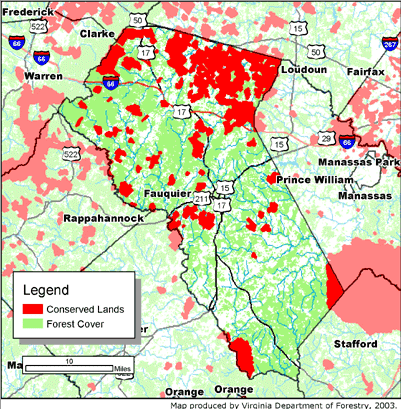
In addition, many wealthy landowners in the northern part of Fauquier County and southwestern Loudoun County have chosen to voluntarily donate conservation easements. These landowners are committed to conserving their landscape, and did need to develop their lands in order to have sufficient retirement income. (The donation of development rights, usually help in perpetuity by the Virginia Outdoor Foundation, provides some tax advantages that mitigate the economic loss.)
The easements guarantee a large-scale protection of the scenic view, so the area will never look like Centreville or Ashburn. In 50 years, if you want to see private land in Northern Virginia where buildings do not dominate the landscape - check out the area between Warrenton and Middleburg.
Read:
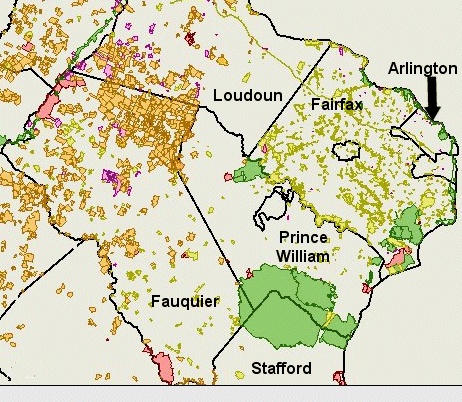
In contrast to the shrinking potential to see natural areas 50 years from now, there will be more historic sites than ever before in 2058. Some of those sites are available today. You can see the Iwo Jima Memorial and Arlington Cemetery, Mount Vernon and Great Falls, the Carlyle House and Rippon Lodge.
Some sites will become popular to visit in the next 50 years due to anniversaries of famous events. Salona will be in the news in 2014, the 200th anniversary of the flight of the Madisons. If you are 30 years old now and if the life insurance actuaries are correct, you have a good chance to live long enough to see the 200th anniversary of the first battle of Manassas in 2061. (If you're feeling like you might not last that long - cheer up, the 150th anniversary will be July 21, 2011.)
Other new sites will become historic over time - historical sites are a renewable resource. To qualify for listing on the National Register of Historic Places, properties generally have to be at least 50 years old. The first subdivisions (such as Colonial Village in Arlington County) are already listed on the National Register. A house built yesterday will qualify in the year 2058 - so look for efforts to conserve vinyl-sided McMansions in about 25 years, just as we see efforts today to conserve all-metal Lustron homes built in 1948-50.
Polish your crystal ball, and consider what might be other possible historic sites of the future. Think we'll be looking for funds to preserve a stretch of the Beltway or even Woodrow Wilson Bridge, as an artifact of the era when cars were the dominant form of transportation? Think we'll set aside a cell phone tower, just as we conserved Colvin Run Mill and Aldie Mill to document the technology of a previous era? Think we'll see fights to preserve the Patriot Center on the Fairfax campus of GMU?
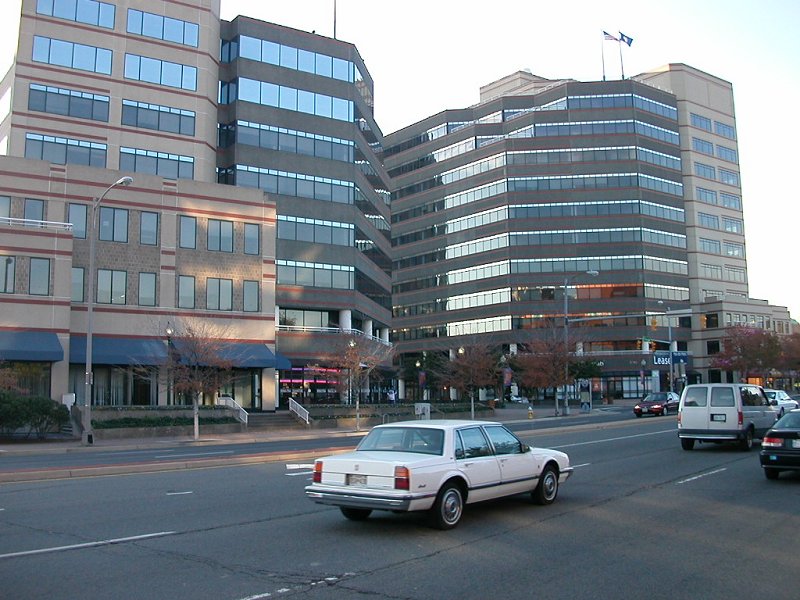
1. "Anticipating the Future: A Discussion of Trends in Fairfax County," March 2006, p.3, http://www.fairfaxcounty.gov/demogrph/pdf/anticipating_future.pdf" (last checked April 23, 2008)
2. Virginia Performs website - Natural, Historic & Cultural Resources, http://vaperforms.virginia.gov/i-preservedLand.php (last checked April 29, 2008)